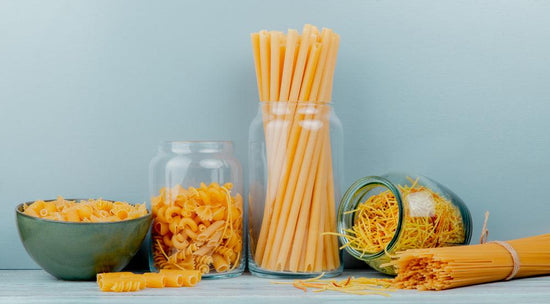Which Pasta is Good for Weight Loss?


Pasta, a staple in many diets, is often perceived as a hurdle in weight loss regimes. This article challenges this misconception by examining the role of pasta in weight loss. It aims to identify pasta varieties that contribute to weight management and suggest ways to integrate them into a healthy diet. The narrative underlines pasta's compatibility with weight loss when chosen and consumed judiciously.
Traditional pasta, primarily made from wheat, is a significant source of carbohydrates. A typical serving contains about 75 grams of carbohydrates, 3.5 grams of fiber, 7 grams of protein, and roughly 365 kilocalories. Dr. Emily Martin, a nutritionist, states, "While traditional pasta is often seen as a 'bad' food in dieting, its moderate consumption can fit into a weight management plan." The key lies in portion control and balancing it with other nutrients.
The myth that pasta unequivocally leads to weight gain lacks nuance. A 2017 study in the journal 'Nutrition & Diabetes' found that pasta consumption in the context of a low-glycemic index diet did not contribute to weight gain and could even aid in weight loss. This finding contradicts the broad-brush belief that pasta is inherently fattening. It's about the type of pasta and how it's incorporated into the diet.
Whole wheat pasta, made from whole grains, offers more fiber and nutrients compared to its refined counterpart. The increased fiber content contributes to a feeling of fullness, aiding in appetite control. Additionally, whole wheat pasta has a lower glycemic index, meaning it causes a slower rise in blood sugar levels, as highlighted by Dr. Martin. This attribute makes it a suitable option for those managing weight and blood sugar.
Legume-based pastas, such as those made from lentils, chickpeas, or black beans, are gaining popularity in weight loss diets. They boast a higher protein and fiber content than traditional pasta. Dr. John Parker, a dietician, notes, "The increased protein and fiber in legume-based pasta can be effective for weight management, as they contribute to satiety and reduced calorie intake." These pastas can be integral in a weight-conscious diet.
Vegetable pastas, like zucchini noodles and spaghetti squash, are low-calorie alternatives to traditional pasta. Their low carbohydrate content makes them ideal for weight loss diets. Dr. Parker explains, "Vegetable pastas increase the overall intake of vegetables, thereby offering additional nutrients and fiber with fewer calories." This option is particularly beneficial for those looking to reduce calorie intake without compromising on volume.
Shirataki noodles, made from the konjac plant, are exceptionally low in calories and carbohydrates. Their unique glucomannan fiber content is noteworthy. According to Dr. Martin, "Glucomannan has been studied for its potential in promoting satiety and aiding weight loss." These noodles can be a valuable component of a weight loss diet, offering the experience of eating pasta with minimal caloric impact.
Each pasta type mentioned aligns with the overarching theme of this article: identifying pasta that supports weight loss goals. The choice of pasta, coupled with mindful consumption and dietary balance, can make pasta a compatible ally in weight loss.
The significance of portion control in a weight loss diet cannot be overstated, especially when it comes to pasta. Dr. Laura Johnson, a dietitian, advises, "A standard serving of cooked pasta is about 75-100 grams, which may be less than what many are accustomed to." To measure this, using a kitchen scale or visual cues such as comparing to a tennis ball can be effective.
Balancing pasta with other food groups is crucial for nutritional completeness. Pairing pasta with lean proteins like chicken, fish, or tofu and a variety of vegetables can create a well-rounded meal. This approach not only enhances the meal's nutrient profile but also aids in achieving a feeling of fullness with fewer calories.
Incorporating healthy pasta recipes is essential in a weight loss diet. For instance, a whole wheat spaghetti dish with grilled chicken, cherry tomatoes, and a sprinkle of Parmesan offers a balanced meal. Alternatively, a chickpea pasta salad with mixed greens, cucumbers, and a light vinaigrette can serve as a nutritious lunch option.
When it comes to sauces and toppings, opt for tomato-based sauces rather than creamy ones and load up on vegetables for added fiber. Toppings like fresh herbs, spices, and a modest amount of cheese can enhance flavor without significantly increasing calorie content.
Integrating pasta into a balanced diet requires mindfulness to avoid overindulgence. Dr. Johnson suggests, "Consider pasta as one component of your meal, not the central focus." Timing is also a factor; eating pasta post-workout, for example, can be beneficial as the body uses the carbohydrates for muscle recovery.
Avoiding pitfalls like heavy, creamy sauces and oversized portions is key. Opt for lighter sauces and be vigilant about serving sizes to keep the meal within the realms of a weight loss-friendly diet.
In conclusion, pasta can indeed be a part of a weight loss diet when chosen wisely and consumed in moderation. Experimenting with healthier pasta options such as whole wheat, legume-based, or vegetable pastas can add variety and nutritional value to your diet. It's about making informed choices and enjoying the diversity of food within the framework of health goals. The integration of pasta in a balanced, portion-controlled diet underscores its role in a healthy, sustainable approach to weight loss.
Plus get the inside scoop on our latest content and updates in our monthly newsletter.